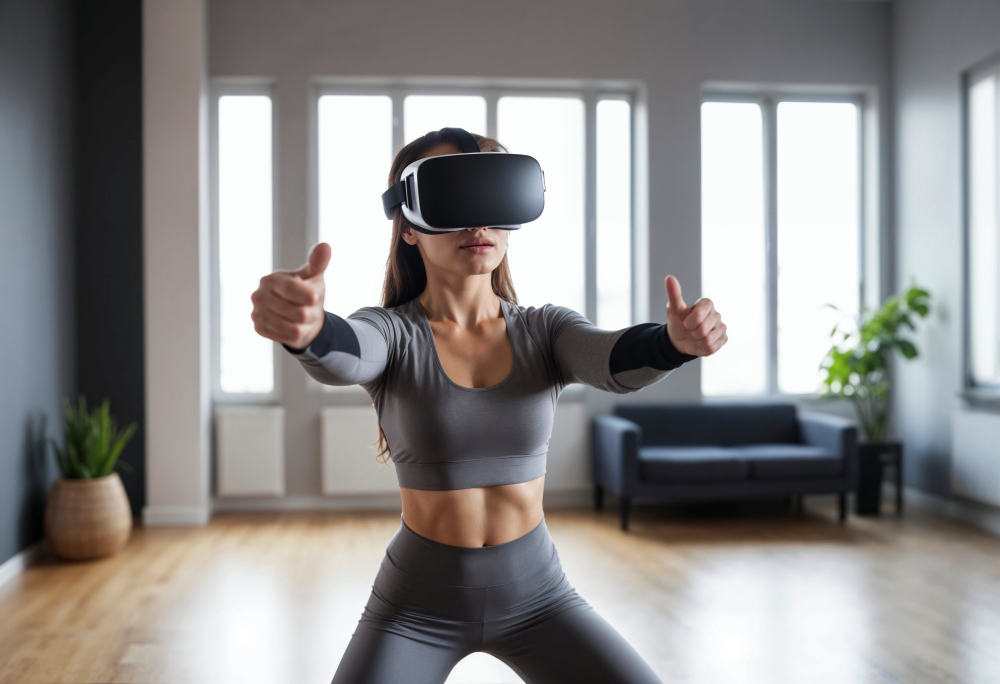Transforming Exercise Through VR: How Technology Can Make Workouts a Pleasure
In the ever-evolving landscape of fitness technology, the integration of Virtual Reality (VR) with physical exercise is emerging as a game-changer. Recent research from the University of Bath has unveiled a revolutionary approach where VR games adapt to the user’s emotional state, potentially transforming exercise from a mundane task into an enjoyable experience. This advancement in emotionally intelligent VR exercise, powered by cutting-edge sensor technology, promises to revolutionize fields like physical education, sports science, and rehabilitation.
The Challenge of Motivation in Exergaming
Exergaming: A Blend of Physical Activity and Entertainment
Exergaming, which merges physical exercise with gaming, has surged in popularity as a way to stay fit while having fun. However, despite its innovative approach, many people struggle with motivation over time. Research indicates that adherence to exergames is often low, particularly when workouts become repetitive or excessively challenging. While integrating screen time with physical activity is a compelling concept, it has yet to address the fundamental issue of long-term commitment.
Can Emotional Sensors Solve the Motivation Problem?
Researchers at the University of Bath are pioneering a solution using sensor technology to detect emotional responses during exercise. This innovative system adjusts the game’s difficulty based on the user’s emotional and physiological state, offering rewards when users are struggling and increasing challenges when they are ready for more. By personalizing the experience, this approach aims to make exercise enjoyable even during the most challenging stages.
How Emotional Sensors Work
The Role of Physiological Sensors
In their study, physiological sensors were embedded in VR headsets and wearable devices to monitor users’ emotional states during exercise. These sensors tracked key indicators such as heart rate, sweating, pupil size, skin inflammation, and electrodermal activity—a measure of stress levels. The system continuously analyzes these variables to provide real-time adjustments to the VR environment, keeping users engaged and motivated.
Addressing Background Noise in VR Sensors
A significant challenge for sensor technology in VR is handling background noise caused by the user’s movement and changes in the virtual environment. Traditional sensors, such as those tracking pupil dilation, often struggle to accurately measure emotions during physical activity. The University of Bath researchers addressed this by developing advanced noise-canceling algorithms that ensure sensors capture genuine emotional responses rather than irrelevant data.
Eight Guidelines for Creating Adaptive Exergames
Based on their findings, the researchers have outlined eight key recommendations for game designers to enhance emotional engagement in VR exergames:
- Correct for Virtual Environment Luminosity: Sensors that detect pupil size should adjust for changes in lighting in the virtual world to avoid misinterpreting emotional responses.
- Account for Preexisting Sweat Levels: Sweating can indicate both physical exertion and emotional stress. Designers should consider a user’s baseline sweat levels to accurately assess their emotional state.
- Data Cleaning: Signals unrelated to emotional changes should be filtered out during gameplay, ensuring a tailored experience for each user.
- Use Multiple Physiological Sensors: Combining various sensors improves the accuracy of emotional state predictions, enhancing the adaptive nature of the game.
Impact on Physical Education and Sports Science
VR in Schools and Rehabilitation
The integration of VR-based exercise into educational curriculums has the potential to reshape physical education. Schools are already incorporating VR programs, allowing students to engage in physical activities in a fun and immersive manner. Additionally, rehabilitation programs for individuals recovering from injuries could benefit significantly from emotionally adaptive exergames, helping patients remain motivated throughout their recovery.
The Future of Sports Science
In the realm of sports science, emotionally intelligent VR exergames could offer personalized training programs that respond to an athlete’s mental and physical state in real-time. By continually adjusting the level of difficulty, these programs could help athletes push their limits while minimizing the risk of burnout or injury.
The Science Behind Emotional Sensing in VR
Measuring Emotions During Physical Activity
During the study, 72 participants engaged in a VR cycling game while wearing sensors that recorded various physiological changes. They cycled through virtual environments designed to elicit specific emotions—happiness, stress, sadness, and calmness—at varying exercise intensities. Analyzing this data allowed researchers to develop a profile of how emotional states fluctuate during physical exertion and adjust the game’s challenges accordingly.
Future Applications of Emotional Sensors
The potential applications of this technology extend beyond gaming. Smart wearable devices, such as VR headsets and smartwatches, could be equipped with emotional sensors to provide real-time adjustments in other settings, such as workplace wellness programs or athletic training. These devices could offer personalized feedback based on users’ emotional and physical states, optimizing performance and enhancing overall well-being.
How VR Exergames Could Change Fitness Forever
Enhancing User Experience with Adaptive Technology
With the capability to adapt to a person’s emotional state, VR exergames signify a major advancement in fitness technology. Adaptive technology not only boosts user engagement but also ensures that workouts are more effective by offering personalized challenges and rewards. This innovation could be key to overcoming the long-standing issue of low adherence to traditional exercise programs.
A Promising Future for VR Fitness
The future of fitness may well be shaped by emotionally intelligent VR systems. As Dr. Christof Lutteroth, co-investigator at CAMERA, notes, “We expect VR physical activity to explode in popularity in the coming years.” This trend is already apparent as schools and rehabilitation centers begin incorporating VR into their programs. With ongoing improvements, VR exercise is poised to become increasingly sophisticated, emotionally intelligent, and widely adopted.
Conclusion: Emotionally Intelligent VR Exercise Is the Future
The research from the University of Bath marks a significant milestone in the development of VR exergames that respond to emotional cues, offering a more engaging and rewarding exercise experience. By tackling the challenges of motivation and boredom, this innovation has the potential to transform not only fitness but also physical education, rehabilitation, and sports science. As VR technology advances, emotionally adaptive exergames could soon become a mainstream solution for maintaining physical health and overall well-being.
This breakthrough in emotionally intelligent VR signifies the dawn of a new era in fitness technology, where exercise can be tailored to each individual’s emotional and physical needs, making it a truly enjoyable experience.








